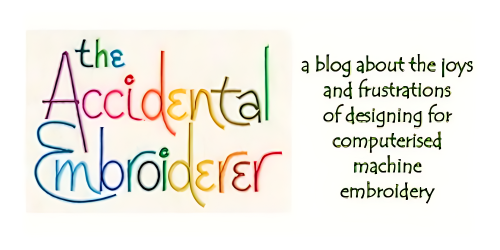I’ve always liked the mad, unplanned look that you can get from good crazy quilting, where unexpected decorative stitching joins areas of different colours. The look is usually a bit naïve and folk-arty but sometimes the effect of the unexpected colour and stitch combinations can be surprisingly sophisticated. Most crazy patching is used in abstract quilting but I wondered if it could perhaps be used in more figurative designs
I did a simple sketch of a bird, digitised it as an appliqué, and added decorative stitching between the different areas of fabric. Although it’s possible to design original stitch patterns, for this first attempt I used the built-in stitches available in my embroidery machine. If I were to use this technique routinely I would design my own decorative stitches

Crazy applique, first version. Maybe a little over the top?
My first efforts were interesting, if not very good. I liked the extravagant textured stitching between the “feathers” of the tail and wing, but the texture on the outline of the back and tail was a bit too much – it gave the bird a fuzzy and undefined look. The outline of the head and breast wasn’t quite so bad, but I thought it might have been better as a smooth finish

Crazy applique, second version. Definitely under the top…
So I re-did some of the stitching to make it lie more tightly against the outline of the bird. However to my mind this looked a little boring, and lacked some of the exuberance of the first version, even if the first version was a bit on the crude side. You can’t win! So this wasn’t an entirely successful experiment. Also there are some technical problems with this approach and it wouldn’t be applicable to all designs. However it’s something that might be used with things like extravagant flowers or animals in a Jacobean or crewel style, especially if the decorative stitching were limited to the interior of the design
